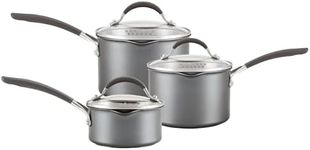Buying Guide for the Best Saucepan Sets
Choosing the right saucepan set can make a significant difference in your cooking experience. A good set should be durable, versatile, and suited to your specific cooking needs. When selecting a saucepan set, consider the material, size, heat conductivity, and ease of cleaning. These factors will help you find a set that enhances your culinary skills and fits well in your kitchen.MaterialThe material of a saucepan set affects its durability, heat conductivity, and ease of cleaning. Common materials include stainless steel, aluminum, copper, and non-stick coatings. Stainless steel is durable and resistant to rust, but it may not conduct heat as well as other materials. Aluminum is lightweight and conducts heat efficiently, but it can be prone to scratching. Copper offers excellent heat conductivity but requires more maintenance. Non-stick coatings make cleaning easier but can wear off over time. Choose a material based on your cooking habits and maintenance preferences.
SizeSaucepan sets come in various sizes, typically ranging from small (1-2 quarts) to large (4-6 quarts). The size you need depends on the quantity of food you usually cook. Smaller saucepans are ideal for sauces, reheating leftovers, or cooking small portions. Medium-sized saucepans are versatile for everyday cooking, while larger ones are suitable for soups, stews, and boiling pasta. Consider your typical meal sizes and choose a set that includes the sizes you will use most frequently.
Heat ConductivityHeat conductivity refers to how evenly and quickly a saucepan heats up. Materials like copper and aluminum have high heat conductivity, ensuring even cooking and reducing hot spots. Stainless steel, while durable, may not conduct heat as evenly unless it has an aluminum or copper core. Good heat conductivity is important for precise cooking and preventing food from burning. If you often cook delicate dishes that require precise temperature control, prioritize saucepans with high heat conductivity.
Ease of CleaningEase of cleaning is an important factor, especially if you cook frequently. Non-stick saucepans are the easiest to clean, as food residue doesn't stick to the surface. Stainless steel and aluminum can be more challenging to clean, especially if food gets burnt. Some saucepans are dishwasher safe, which can save time and effort. Consider how much time you want to spend on cleaning and choose a set that aligns with your preferences.
Handles and LidsHandles and lids are often overlooked but are crucial for convenience and safety. Look for saucepans with sturdy, heat-resistant handles that provide a comfortable grip. Some handles are designed to stay cool, which can prevent burns. Lids should fit well and ideally be made of tempered glass, allowing you to monitor cooking without lifting the lid. Consider your comfort and safety when choosing handles and lids.
















